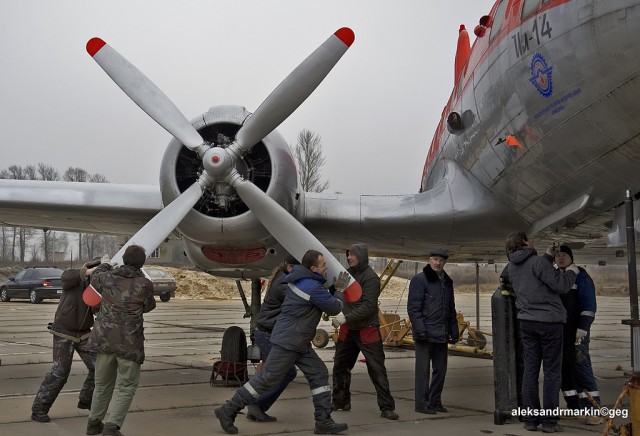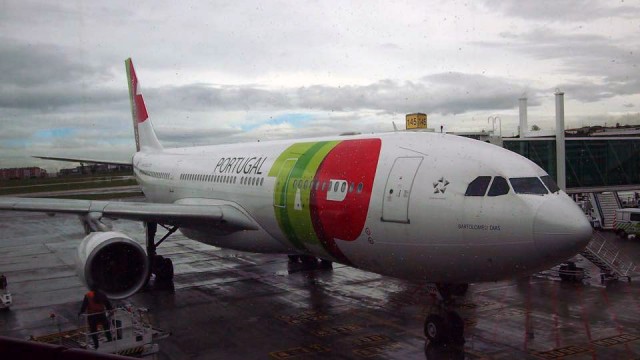
My TAP A330-200 (named Bartolomeu Dias – reg CS-TOR) sitting at Lisbon – Photo: Katka Lapelosová
Recenty, I was booked to fly on TAP airlines from Newark Liberty International Airport (EWR) to Lisbon Portela Airport (LIS). On my way there, I flew on their Executive product (aka business class) and on the way home, I flew in economy.
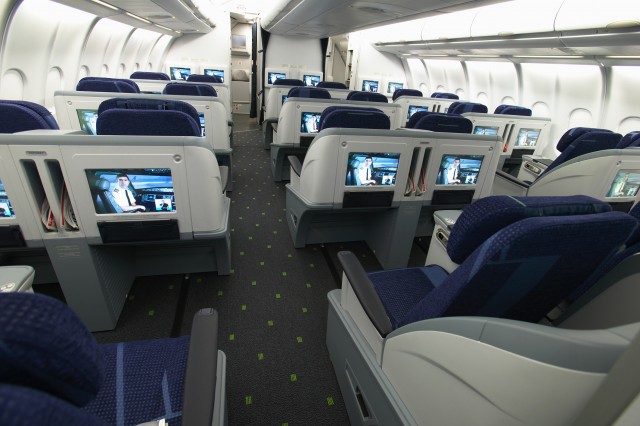
TAP Executive cabin – Photo: TAP
At the airport, I looked for a priority line, but did not see one, so I waited in the standard line. Upon check-in, I was provided with a green sticker on my boarding pass, which indicated I was to receive an expedited security clearance. There was no discussion of whether I had lounge access and the ticket agents did not seem to know — actually, different agents told me to go to different lounges.
I was a bit frustrated, but it was only an hour until my flight anyway, so I decided to relax in a secluded part of the gate with the economy passengers. Checking out TAP’s website, I was able to confirm that I had access to the Lufthansa’s Business Class lounge in Terminal B.
Excerpt was written by David J. Williams, who is a former airline captain and currently involved with aviation safety, on NYCAviation.com.
For many of us, our first understanding on how to start an airplane was when Bugs Bunny started the engines of the ’œWorld’s Largest Airplane’ in Hare Lift (FF to 2:04). With a simple push of a button, all of the radial engines were up and running. And as ridiculous as that was, in the sixty years since, starting the modern jet engine has become just as simple as that.
In the Beginning
A century ago, when the Wright brothers started up the four-cylinder engine on the Wright Flyer, they did so by hand. This was the method for the farm tractors, motorcycles, and automobiles of the time, as the electric starter was still several years away. Even had the Wright brothers had access to an electric starter, they likely would have rejected it to keep the weight and complexity of the Wright Flyer to a minimum.
Even after the electric starter became available, during the several decades following the Wright’s flight, the majority of the airplanes produced chose to reject the heavy and expensive electric starter and relied on the pilots hand-propping their new airplanes. Though it seems to be highly dangerous, it is a safe with proper training.
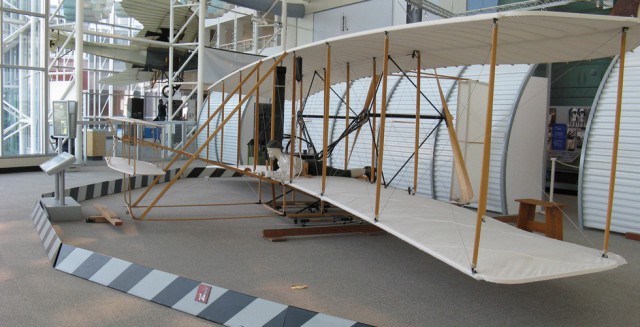
Replica of the Wright Flyer at the Museum of Flight – Photo: MoF
When hand-propping an aircraft, the person outside is the one in control, though the pilot will typically direct the sequence. The engine will then be turned over several times with the ignition off to purge the cylinders of stale air and oil, which is especially critical on radial and inverted engines. Gasoline will then be either poured directly into the intake manifold, or injected with a small hand pump in the cockpit. The person propping then checks the security of the brakes by pulling and pushing on the propeller, and then calls ’œContact!’ instructing the pilot to turn on a magneto. The term contact is often used to better differentiate between the calls of having ignition system on or off; Contact is used to denote Magneto (or Mag) On, and not to be confused with Mags Off.
The propeller would then be pulled through one compression stroke at a time with the magneto on. When the engine started, the pilot would then resume control of the airplane – adjusting the throttle for proper idle, switching on a second magneto, checking oil pressure, and completing the start procedure from memory.
Continue reading The Evolution of Engine Starting: From Hand-Propping to Button Pushing on NYCAviation.com
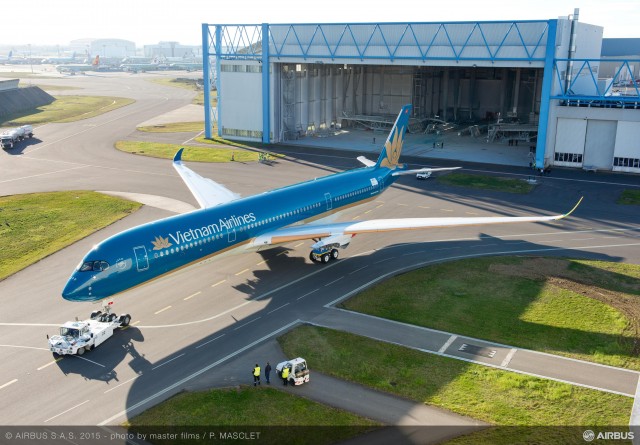
The initial A350 XWB for Vietnam Airlines rolled out of Airbus’ Toulouse paint shop on 6 March 2015, displaying the airline’s updated blue and gold lotus livery
Vietnam Airlines, the government-owned national flag carrier for Socialist Republic of Vietnam, is on the cusp of its first major international expansion in over a decade.
The airline has made no secret of its desire to become the second-largest carrier in Southeast Asia by 2020, behind Singapore Airlines. With the financial near-collapses of regional competitors Thai Airways and Malaysia Airlines and the upcoming expansion of its long-haul fleet, Vietnam Airlines is poised to gain significant market share and inch closer to its goal of regional domination.
A member of the SkyTeam alliance, Vietnam currently operates a full-service schedule to 52 destinations in 17 countries, with an active fleet of 77 aircraft.
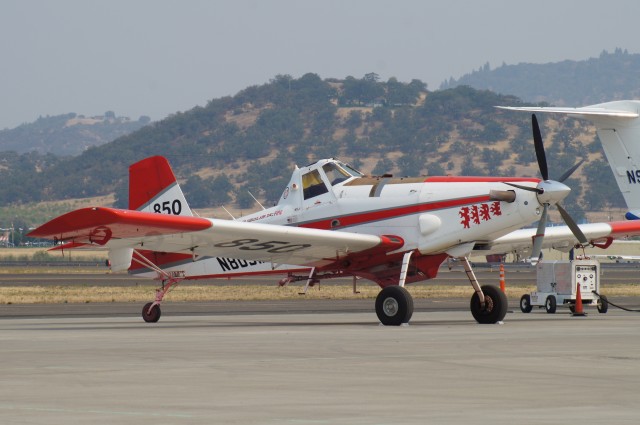
An AT-802F Air Tractor (check out the “fire words” on the nose) – Photo: Julian Cordle
Last November, I brought you an initial introduction into the world of Aerial Firefighting. That article focused on the concept, tactics and state of aerial firefighting. I promised a second look at the aircraft of Aerial Firefighting, so here we go!
First, let’s review the types of fixed-wing aerial firefighting aircraft and the associated designations and acronyms.
SEATs (Single Engine Air Tankers) are short-range, small, one-person aircraft with less than approximately 1,000 gallons of usable retardant capacity. The most well-known example here is an AT-802F Air Tractor and the ’œFire Boss’, which is a model AT-802F fitted with floats.
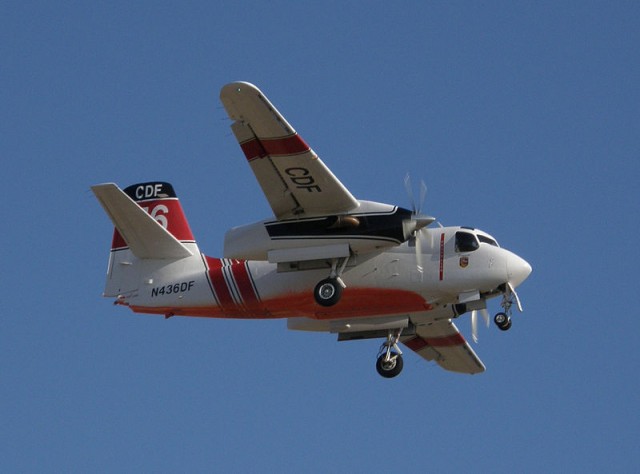
A Grumman S-2T converted to fire fighting duty – Photo: Alan Radecki | WikiCommons
Next we have the Large Air Tankers (LATs): of Type III, II, and I. Type III air tankers can dispense approximately 1,200 gallons per drop. The best example in this class could be the Grumman S-2T, which are re-engined Grumman S-2 ’œTracker’ Navy patrol aircraft. CalFire currently has 20+ of these in service.
Type II tankers include such interesting aircraft as the purpose-built Canadair CL-215 ’œSuperScooper’, with high, oversized wings and v-hull for scooping up up to 1,250 gallons of water to deliver to a fire.
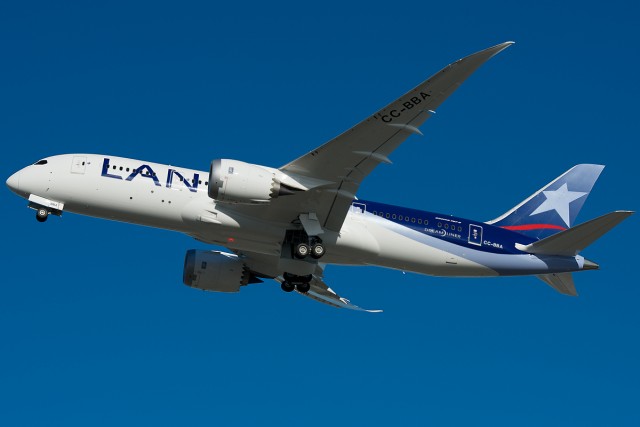
LAN 787-8 Dreamliner at takeoff – Photo: Bernie Leighton | AirlineReporter
Recently, LAN Airlines invited me down to their headquarters in Santiago de Chile, Chile, to check out their new Boeing 787-9 Dreamliner. While LAN was the first carrier in the Americas to operate the 787-8, the new stretched 787-9 offers an all-new Premium Business hard product. Unfortunately, at the last minute, the special event was called off due to “operational issues.”
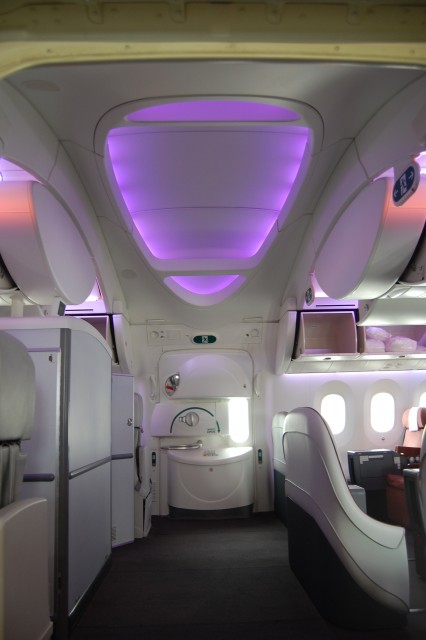
Dreamliner signature entryway on LAN’s 787-8 – Photo: Blaine Nickeson | AirlineReporter
Since flights to Santiago had already been arranged I decided to still make the trip, which would give me a chance to experience LAN’s 787-8 Premium Business class, check out Santiago briefly, and also take a look at the airport experience on both ends. All-in, I’d only be gone from home in Denver for 55 hours – not too shabby for 13,000 miles of travel.


